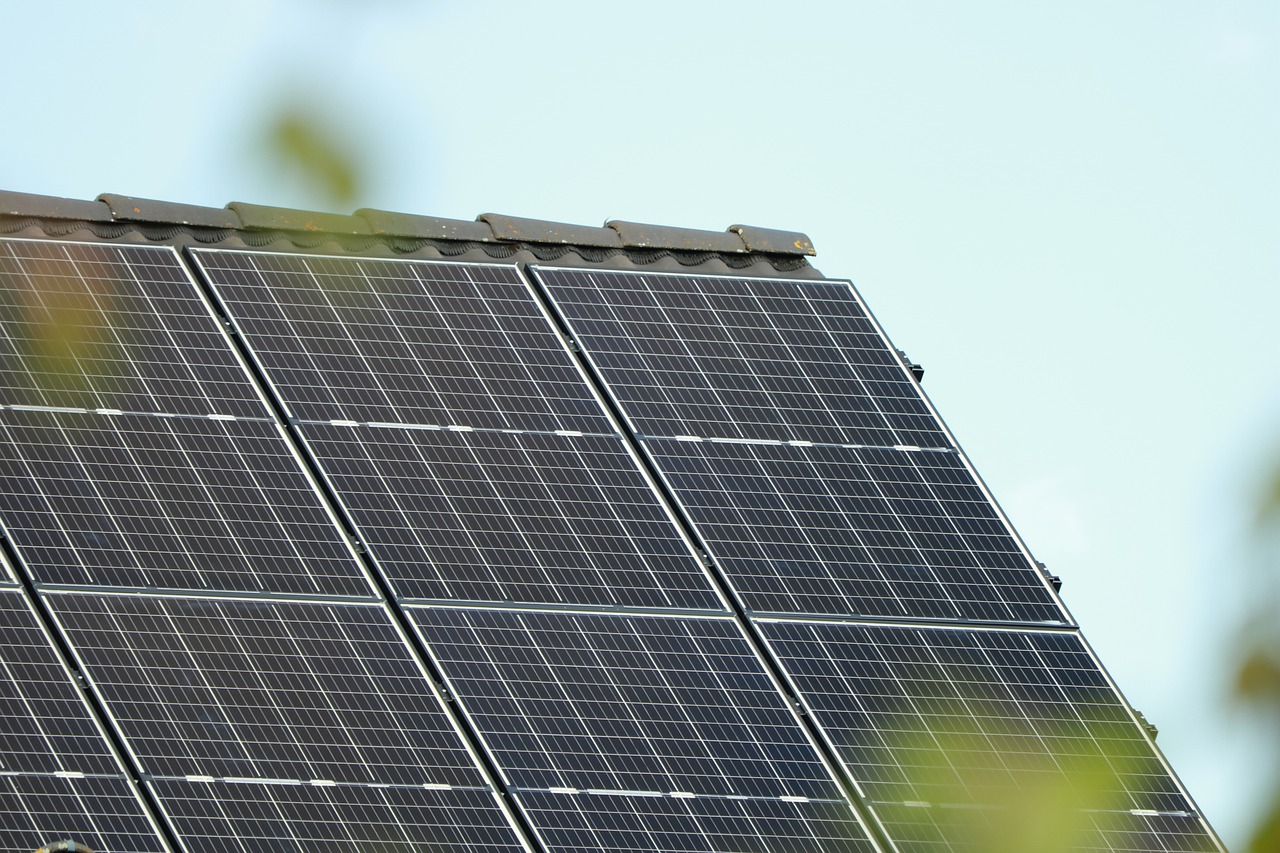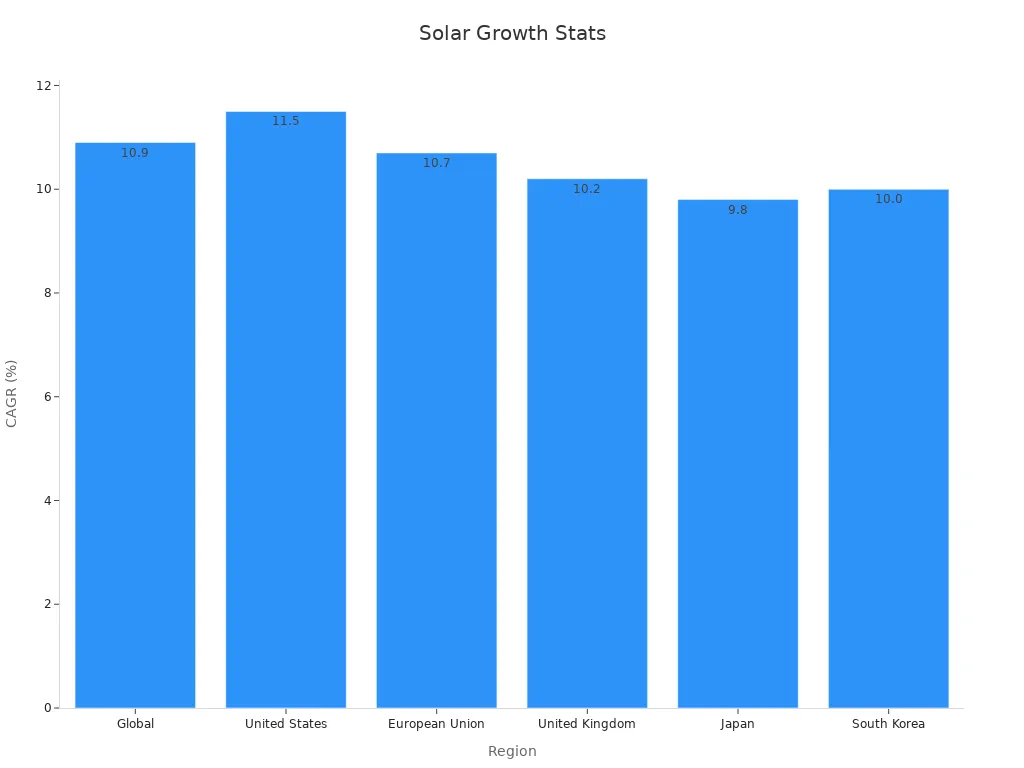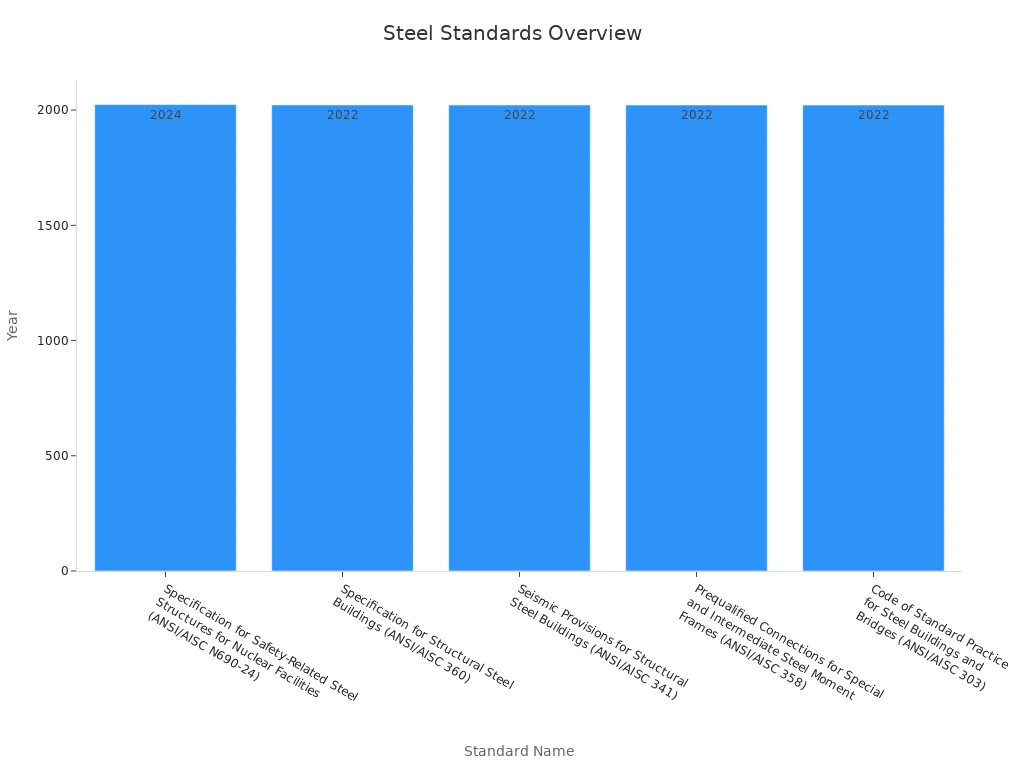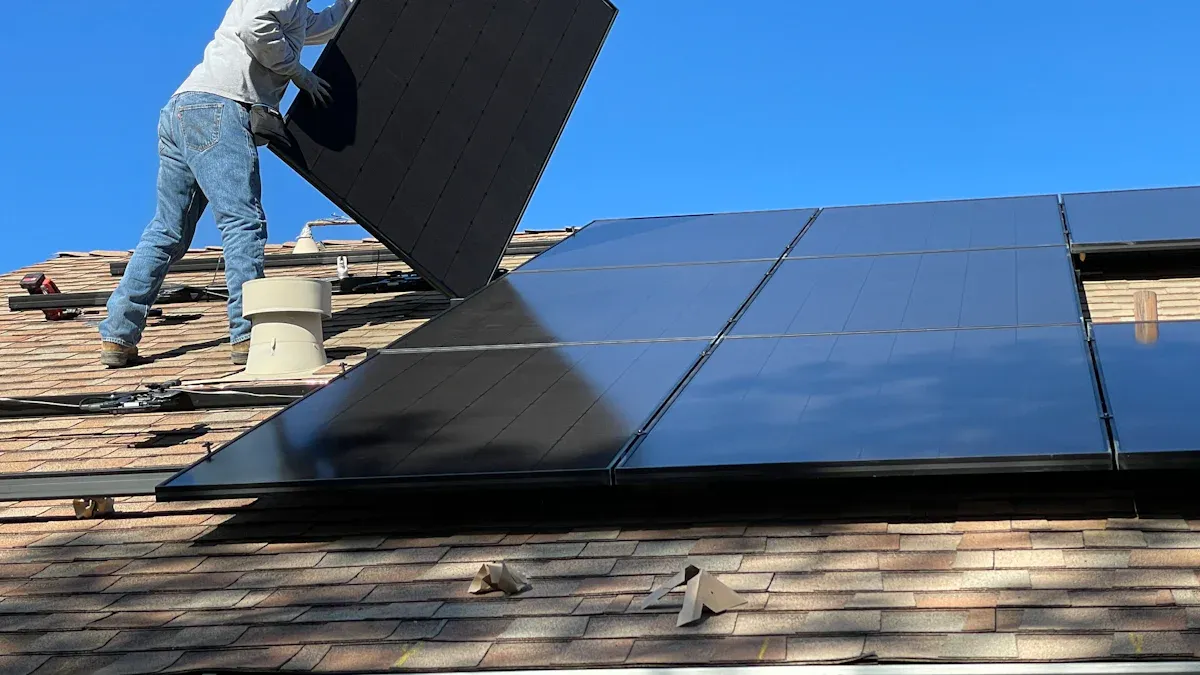What to Consider When Choosing Steel Structures for Solar Panels in 2025

Choosing the right steel structure for solar panel installation in 2025 requires careful attention to strength, durability, and corrosion resistance. A strong system supports the panels and maintains the integrity of each installation. The demand for solar installations continues to rise as renewable energy becomes a priority worldwide.
Metric/Region | Value/Projection |
|---|---|
Market Size (2025E) | USD 21.3 billion |
Market Value (2035F) | USD 59.6 billion |
CAGR (2025 to 2035) | 10.9% |
United States CAGR | 11.5% |
European Union CAGR | 10.7% |
United Kingdom CAGR | 10.2% |
Japan CAGR | 9.8% |
South Korea CAGR | 10.0% |

A reliable system must comply with updated safety codes and support a range of solar panel system types. Every installer should match the steel structure to the site conditions and the panels used. With more solar installations in residential, commercial, and utility sectors, the right system ensures each installation delivers lasting benefits.
Key Takeaways
Choose steel structures that offer strong support, durability, and corrosion resistance to ensure long-lasting solar panel installations.
Match the steel type and coatings to your site’s environment to protect against weather and corrosion, especially in harsh climates.
Consider load and design requirements carefully, including wind, snow, and seismic forces, to keep solar panels safe and stable.
Follow updated safety codes and industry standards to meet legal requirements and ensure reliable, secure installations.
Balance upfront costs with long-term savings by selecting steel structures that reduce maintenance and improve energy efficiency.
Steel Structure Basics
Why Steel Structure Matters
A steel structure forms the backbone of any solar panel installation. It provides the essential support that keeps panels stable, even under heavy loads from snow or strong winds. Engineers select steel structures for their strength, durability, and ability to maintain integrity in harsh environments, such as coastal or desert regions.
Steel structures, like those made from ESTEL steel, meet international engineering standards for safety and long-term performance.
Their modular and pre-engineered designs simplify installation, which reduces labor time and costs.
Mechanical and environmental tests, including load testing and hail impact testing, confirm the reliability of these supports.
Steel’s recyclability also supports sustainability goals in solar projects.
Research shows that optimized steel structure designs can increase energy output and reduce costs. For example, a four-column steel structure configuration demonstrated the highest energy efficiency in recent studies. Decision support systems now help users select the most efficient design based on location and project needs.
Note: A well-chosen steel structure ensures the solar system remains safe, efficient, and cost-effective throughout its lifespan.
Types of Steel Used
Solar panel installations use several types of steel, each offering unique benefits:
Steel Type | Key Benefits | Common Use Cases |
|---|---|---|
Galvanized Steel | High corrosion resistance, cost-effective | Outdoor ground mounts |
Stainless Steel | Superior durability, excellent for harsh climates | Coastal or industrial sites |
Cold-Formed Steel | Lightweight, easy to fabricate, strong | Rooftop and carport systems |
Manufacturers often choose light-duty structural steel, such as angle steel and thin-walled steel, for their adaptability and strength. Carbon structural steel and low alloy steel offer a balance between cost and mechanical performance. Key requirements for these materials include high tensile and yield strength, good toughness, and strong corrosion resistance. These properties ensure the steel structure can support solar panels for over 20 years, even in challenging environments.
Key Factors
Material Quality
Material quality stands as a primary consideration in any solar panel installation. High-grade steel ensures the framework for securing solar panels meets strict requirements for strength and longevity. Industry standards, such as those from the International Electrotechnical Commission (IEC), set requirements for mechanical properties, environmental resistance, and safety. These requirements guarantee that steel components maintain performance under temperature changes, humidity, and UV exposure.
A variety of steel grades and treatments exist for solar installations. Galvanized steel, stainless steel, and cold-formed steel each offer unique benefits. The table below outlines common steel components and their specifications for solar panel mounting structure applications:
Steel Component | Steel Grade / Gauge | Coating / Treatment | Application / Importance |
|---|---|---|---|
Torque Tubes | 10-12 gauge | G90 galvanization | Structural support for solar panels in tracker systems; durability and corrosion resistance are critical |
Purlins/Trusses | 8-20 gauge | G90 to G180 galvanization | Framework for fixed tilt panels; ensures stability and structural integrity |
Steel Beams | Various sizes | Galvanized post-processing | Used in carport frames and piles; provides robust foundation and resistance to environmental factors |
Earth Screws | 3-4 inch OD tubular steel | Galvanized post-processing | Foundation support in rocky terrain; ensures rapid installation and stability |
Quality assurance in solar installations relies on precise metal processing, including roll forming and fabrication. These processes help meet the requirements for reliable, long-lasting support structures. Research confirms that steel’s durability and adaptability make it the preferred material for solar panel system frameworks, especially when exposed to environmental stresses.
Tip: Always verify that steel grades and coatings meet the requirements for your specific site and climate.
Load and Design
Load and design requirements determine the safety and effectiveness of any solar panel installation. Engineers must evaluate dead loads (the weight of the system itself), live loads (temporary forces), and environmental loads such as wind, snow, and seismic activity. These requirements ensure the structural support for solar panels can withstand all expected forces throughout the system’s lifespan.
Industry reports highlight that structural requirements for solar panels include robust support, proper tilt angle, and careful assessment of shading. Engineering evaluations use mathematical equations, computer simulations, and empirical data to determine design loads. Advanced software tools, such as Autodesk Robot Structural Analysis and STAAD, help model these requirements under diverse conditions.
A comprehensive study of pole-mounted systems found that connection details—such as bolt layout and plate design—significantly affect load capacity. Engineers must consider both strong and weak axes in connection design to prevent failure modes like buckling or bolt tear-out. Collaboration between engineers and installers ensures that the system meets all requirements for load capacity and reinforcement.
Key requirements for load and design:
Assess all load types (dead, live, wind, snow, seismic)
Use proper connection details and reinforcement strategies
Ensure compatibility between mounting system and panels
Consult with structural engineers for site-specific requirements
Corrosion Resistance
Corrosion resistance is essential for the long-term performance of steel in solar installations. Environmental factors such as humidity, temperature, and salt spray can accelerate corrosion, especially in coastal or industrial areas. Requirements for corrosion protection include the use of hot-dip galvanizing, advanced weatherproof coatings, and regular maintenance.
Case studies show that coatings like NiCoCrAlY and CoNiCrAlY, applied through thermal spray methods, provide substantial protection against corrosion in harsh environments. Galvanized steel with thick coatings (G90 or higher) extends the service life of support structures, meeting requirements for durability. Standards and tests, such as Salt Spray (ISO 7253) and Cyclic Test (ISO 20340), validate the effectiveness of these protective measures.
Corrosion resistance requirements:
Select steel with appropriate galvanization or protective coatings
Use corrosion-resistant alloys or advanced coatings in high-risk environments
Follow standards for corrosion testing and certification
Note: Corrosion not only weakens the structure but also affects electrical contacts and overall system performance.
Mounting Methods
Mounting methods play a crucial role in meeting the requirements for solar panel installation. The choice of mounting system affects installation speed, cost, and long-term reliability. Several mounting techniques exist, each with distinct benefits and challenges.
Ballasted mounting systems offer quick installation and versatility for different roof types. However, they have limited tilt options and may face wind uplift concerns.
Ground-mounted systems provide optimal sun exposure and easier maintenance. These systems require careful site preparation and a stable foundation to meet structural requirements for solar panels.
Roof-mounted systems adapt to various architectural forms and maximize urban space. They require a structurally sound roof and may involve additional waterproofing requirements.
Innovations such as rail-free mounting systems reduce material costs and labor hours, improving installation efficiency. Smart ballast solutions optimize weight distribution and enhance wind resistance. Robotic installation systems increase precision and speed, supporting large-scale solar installations.
Long-term performance evaluations emphasize the importance of material strength, corrosion resistance, and protective coatings for all mounting methods. Modular steel designs improve adaptability and meet requirements for different panel types and terrains.
Tip: Always match the mounting method to the site’s structural requirements for solar panels and environmental conditions.
Compliance
2025 Standards
Steel structures for solar panels in 2025 must meet evolving requirements set by updated building codes and industry standards. Municipalities and state agencies now require adoption of the 2021 International Energy Conservation Code (IECC) or better, which includes solar-ready and electric-ready requirements. Local governments, such as those in Boulder and Denver, have adopted advanced codes with additional requirements for solar installations. Connecticut mandates the 2021 IECC as part of its state building code, ensuring consistent requirements across projects.
Standard Name | Year | Description | Relevance to 2025 Steel Structure Selection |
|---|---|---|---|
ANSI/AISC N690-24 | 2024 | Updates for safety-related steel structures in nuclear facilities | Directly affects requirements for steel structure selection |
ANSI/AISC 360 | 2022 | Core standard for structural steel buildings | Sets requirements for general steel structure design |
ANSI/AISC 341 | 2022 | Seismic provisions for steel buildings | Influences seismic requirements for 2025 |
ANSI/AISC 358 | 2022 | Prequalified connections for seismic frames | Supports connection requirements in seismic areas |
ANSI/AISC 303 | 2022 | Standard practice for steel buildings and bridges | Guides procedural requirements for projects |
Material selection, fabrication, and construction must follow strict requirements for quality and performance. Inspection and testing services play a key role in verifying that all requirements are met, from structural integrity to fire safety. North America leads in compliance due to advanced technologies and a strong ecosystem of consultants and testing labs.

Safety Codes
Safety codes for solar panel installations in 2025 focus on both installer and system requirements. Certification programs ensure that installers understand current safety protocols and requirements. Employers keep detailed training records and verify certifications before work begins. Emergency response protocols, including first aid and communication, are updated regularly to meet requirements for safe operations.
Solar panels must pass rigorous safety compliance testing, including fire safety, impact resistance, and mechanical load requirements. Accredited labs conduct these tests, and documentation is maintained throughout the product lifecycle. Certifications such as UL, IEC, and CE confirm that products meet all safety requirements. Regular audits and refresher courses help maintain compliance with evolving requirements.
Safety requirements also include lockout/tagout procedures, structural assessments, and weather-related decisions. These steps protect both workers and equipment during installation and maintenance.
Testing and inspection services dominate the compliance market, ensuring that all requirements for safety and quality are met. This approach helps identify non-compliance early, reducing costly delays and supporting reliable solar installations.
Cost and Value
Upfront vs. Long-Term
When evaluating steel structures for solar installations, decision-makers must compare initial expenses with long-term savings. The choice between cold-formed steel and red iron buildings affects both the construction budget and future maintenance. The following table highlights key financial aspects for a typical 2,000 sq. ft. solar farm structure:
Financial Aspect | Cold-Formed Steel Home Kits | Red Iron Buildings | Notes |
|---|---|---|---|
Initial Construction Costs | $150,000 – $200,000 | $180,000 – $230,000 | Includes materials, labor, and foundation for solar farms |
Time to Completion | 4-6 months | 6-9 months | Faster construction benefits solar power plants and carport solar projects |
Maintenance Costs (Yearly) | $500 – $1,000 | $1,000 – $2,000 | Cold-formed steel reduces maintenance for solar installations and farm structures |
Energy Efficiency | High | Moderate | Better insulation supports energy production in solar farms |
Long-term Savings (20 years) | $20,000 – $40,000 | $10,000 – $20,000 | Lower costs benefit solar farms and solar power plants |
Resale Value | High | Moderate to High | Durability increases value for farm and solar installations |
Insurance Costs | Lower | Higher | Fire resistance lowers premiums for solar farms and carport solar projects |
Cold-formed steel often leads to lower maintenance and insurance costs for solar farms. Faster construction allows solar installations to begin energy production sooner. The foundation type also impacts both upfront and future expenses, especially for large-scale solar power plants.
ROI for Solar Installations
Return on investment (ROI) remains a top concern for solar farms and solar installations. What factors influence ROI? Material selection, engineering quality, and construction speed all play a role. Life cycle cost analysis tools, such as CalBarrier, help compare average annual and lifetime costs for different steel options. These tools account for inflation, interest rates, and real-world variables like traffic or crash rates near farm sites. Sensitivity analysis provides a robust framework for understanding how changes in construction or foundation choices affect total expenses.
Tip: Choosing the right steel structure for solar farms and solar installations can increase long-term savings by reducing maintenance and improving durability.
Solar power plants and carport solar projects benefit from high-quality engineering and careful construction planning. A well-designed foundation supports the structure and reduces repair costs over time. Farm owners and solar developers should focus on what steel structure offers the best balance of upfront cost and long-term value for their solar installations.
Trends for 2025

Metal Structure for Solar Panels
What trends define the metal structure for solar panels in 2025? The industry sees a shift toward advanced materials and smarter designs. Aluminum frames now play a major role in solar farms and rooftop projects. Reports show the global aluminum solar panel frame market will grow at a steady pace, driven by renewable energy adoption and new infrastructure. Aluminum offers durability, corrosion resistance, and thermal conductivity, making it ideal for supporting panels in harsh environments.
Manufacturers form strategic partnerships to scale production and foster innovation. These collaborations help meet the rising demand for metal structure for solar panels in both residential and utility-scale solar farms. Steel structures remain popular due to their strength-to-weight ratio and recyclability. Prefabrication and modular designs allow for faster construction and lower costs. Steel’s flexibility supports creative solutions for solar farms and ground solar farm projects.
Key features of modern metal structure for solar panels include:
High strength and environmental resistance
Lightweight design for easier mounting and reduced foundation needs
Full recyclability for sustainability
Protective coatings for longer lifespan
Case studies highlight how these structures improve efficiency and reduce maintenance for solar farms. The market also sees a focus on hybrid steel-aluminum systems, which combine the best properties of both metals.
Innovations in Mounting
What innovations shape mounting systems for solar farms in 2025? The market introduces flexible and modular mounting systems that adapt to different terrains and climates. Companies invest in research and development to create mounting solutions that speed up installation and lower costs. New systems use pre-assembled parts, making them easy to transport and set up on site.
Tracking technology becomes more common in mounting systems. Advanced solar panel tracking system designs allow panels to follow the sun, increasing energy output for solar farms. Single-axis and dual-axis tracking systems adjust panel angles throughout the day. Smart sensors and monitoring tools help optimize panel alignment and performance.
A table of mounting system advancements:
Feature | Benefit for Solar Farms |
|---|---|
Modular/pre-assembled systems | Faster installation, less labor |
Terrain-adaptive trackers | Better performance on uneven ground |
Weather-resistant coatings | Longer system lifespan |
Automation in manufacturing | Lower production costs, higher quality |
Floating mounting systems | New options for water-based solar farms |
Mounting systems now use lightweight materials, which reduce installation costs and improve durability. Innovations like floating solar farms and smart monitoring systems expand where solar farms can operate. Companies also use shading analysis and precision tilt controls to maximize energy capture from panels.
Note: What sets 2025 apart is the integration of digital tools and automation in mounting system design, making solar farms more efficient and adaptable.
Selecting steel structures for solar panel installations in 2025 involves meeting strict requirements for durability, compliance, and cost. Installers must evaluate requirements for material quality, ongoing maintenance, and adherence to local requirements and safety codes. The table below highlights what requirements matter most:
Aspect | Role in Solar Projects |
|---|---|
Durability | Meets long-term requirements |
Compliance | Fulfills legal and safety requirements |
Cost | Supports financial requirements |
Regular monitoring and data-driven practices help meet requirements for system performance and safety. Certified panels and qualified installers ensure all requirements are satisfied. What sets successful projects apart is a focus on requirements for safety, efficiency, and innovation. Meeting these requirements leads to reliable, long-lasting solar installations.
FAQ
What makes steel structures ideal for solar panel installations?
Steel structures offer high strength, durability, and resistance to harsh weather. They support solar panels securely and last for decades. Many engineers choose steel because it meets strict safety and quality standards.
What types of coatings protect steel in solar projects?
Manufacturers use galvanization, powder coatings, and advanced weatherproof paints. These coatings prevent rust and extend the lifespan of steel structures. Proper coatings help steel resist corrosion in coastal or industrial areas.
What factors affect the cost of steel structures for solar panels?
Material quality, design complexity, and installation method influence cost. Higher-grade steel and advanced coatings increase upfront expenses but reduce maintenance. Prefabricated or modular systems often lower labor costs.
What standards must steel structures meet in 2025?
Steel structures must comply with updated building codes, such as ANSI/AISC and IEC standards. These codes ensure safety, structural integrity, and fire resistance. Regular inspections confirm compliance throughout the project.
What innovations improve mounting systems for solar panels?
New mounting systems use modular designs, lightweight materials, and smart tracking technology. These innovations speed up installation, adapt to different terrains, and boost energy output. Many systems now include weather-resistant features for longer service life.
See Also
Eco-Friendly Intelligent Outdoor Communication Cabinets For The Year 2025
Steel Versus Aluminum: Outdoor Telecom Cabinet Material Comparison
Essential Structural Design Considerations For ESTEL Outdoor Cabinets
Selecting The Ideal Mount For Outdoor Telecom Cabinets
Next-Generation Outdoor Cabinets Designed For 5G Networks And Beyond
CALL US DIRECTLY
86-13752765943
3A-8, SHUIWAN 1979 SQUARE (PHASE II), NO.111, TAIZI ROAD,SHUIWAN COMMUNITY, ZHAOSHANG STREET, NANSHAN DISTRICT, SHENZHEN, GUANGDONG, CHINA
